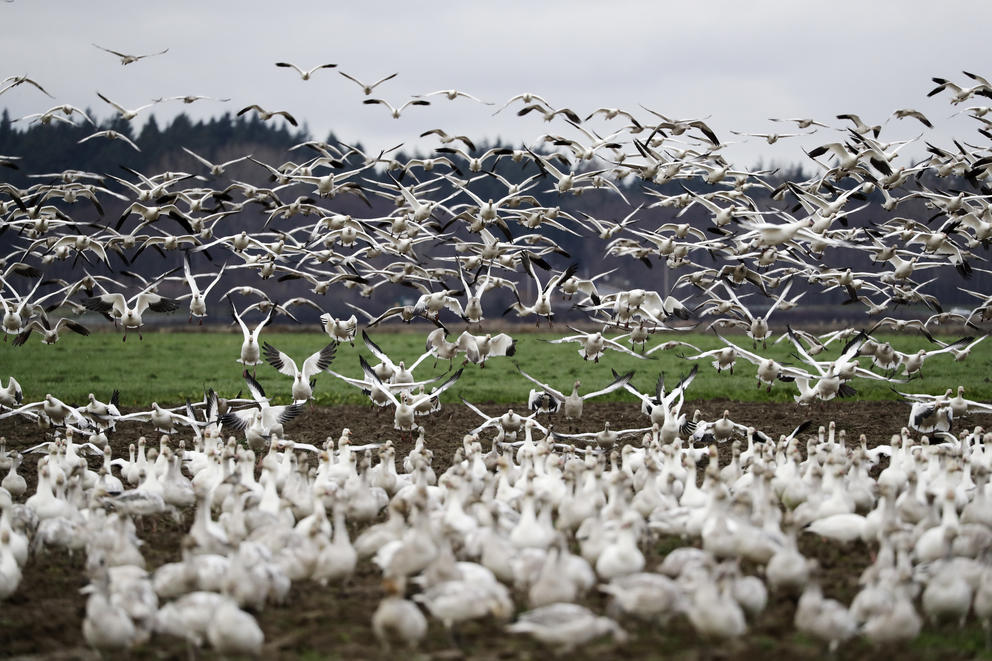The Skagit holds both agricultural and wildlife abundance. The relationship is not coincidental. However, larger market pressures on agriculture threaten the future of habitat availability for the flocks, while the huge flocks damage and consume crops, frustrating farmers who are growing food and running a business, not managing a bird refuge.
Meanwhile, public indifference to or ignorance of the ecological and economic relationships that support wildlife abundance threatens to unravel any tolerance that exists among different user groups and their values.
Competing interests, shared landscape
Hunters, tourists, wildlife photographers, birdwatchers and farmers have distinct relationships and sometimes competing interests when it comes to these wintering flocks. Navigating those can be hard.
“I kind of see it as growing pains,” said Wingard.
On Nov. 17, Wingard spent two hours in the afternoon at the Fir Island Farm Wildlife Area Unit, a popular birding site south of Mount Vernon, handing out signs to any local landowner who wanted one. The yellow signs include a no-parking symbol and read “BIRDS ONLY Beyond This Sign.” They are provided by Be Bird Wise, a new group of interested stakeholders. These signs are one part of an outreach and education campaign designed to increase respect among all with an interest in birds as part of this shared landscape.
Winter brings migrating waterfowl to the Skagit landscape in great numbers. In recent years, the Skagit and Fraser river deltas have welcomed close to 150,000 snow geese from their summer grounds at Wrangel Island in the Chukchi Sea north of Siberia. They cover fields like a giant white blanket. When eagles, dogs, people or vehicles disturb them, they rise and swirl, churning through the air amid a tremendous cacophony of chattering.
If the size of the snow geese flock is astounding, so are the sizes of individual trumpeter swans. Weighing between 20 and 30 pounds each, trumpeters rise off lakes where they roost and must circle to climb high enough to get their plump, yet surprisingly graceful, bodies to clear the surrounding trees. The Skagit Valley is home to the highest concentration of wintering swans in North America. Last year, more than 7,500 spent their days feeding in Skagit fields.
Essential farmland
Those fields are critical for the birds’ survival.
The essential role of agriculture was a key point wildlife biologist Martha Jordan tried to drive home in a talk last week, “White Birds of Winter: Swans and Snow Geese,” for the Skagit Audubon Society. Jordan, executive director of the Northwest Swan Conservation Association who has studied wintering birds for five decades, identified “waterfowl-friendly farming” as critical to their continued abundance here.
Dairies are particularly important for trumpeter swans, Jordan said, as 85% of Western Washington swans are dairy-dependent, benefiting from the associated corn and silage grass.
But dairy is shrinking in Skagit County. According to Washington State University Skagit County Extension, in 1997 76 dairy herds produced nearly 400 million pounds of milk; by the end of 2022, the 16 remaining dairies produced a bit shy of 200 million pounds. More dairies closed in 2023.
The reasons for the decline in Western Washington’s dairy industry are complicated. Milk prices fluctuate, while land values increase. Farmers feel pressure to sell land for new housing developments or to grow more lucrative crops, some transitioning from dairy to berry or hazelnut farms, which are not waterfowl-friendly.
Meanwhile, environmental regulations — “some of them very draconian,” Jordan observed in an interview — have driven dairies to relocate across the Cascade Mountains. (One result is the rapidly increasing numbers of these types of birds in Eastern Washington and Oregon where the dairy industry is growing, although the populations are distinct from the Pacific Coast flocks.)
How much these shifting economic and ecological factors will affect the birds in the Skagit remains an unanswered question. But Skagit is “the absolute dead-center heart of this problem,” Jordan told the Audubon chapter.
In a follow-up interview, she noted that bird population changes are unpredictable, and biologists need to keep studying.
“It’s a dynamic thing that oftentimes we don’t know what’s going to happen unless you just observe that it has happened, and then you asked the question, ‘I wonder why that happened?’” To Jordan, tracking this is “always surprising.”
Flocks of birds … and birders
Skagit farms still provide good, if shrinking, habitat for geese and swans. In fact, flock numbers have increased dramatically over the past couple of decades. The rise of social media and the search for activities during the pandemic sent more people to Skagit to see the wintering flocks. These various groups are not familiar with each other and the rules that govern appropriate behavior.
The vast majority of land where birds feed is privately owned and closed to the public. But private-property lines do not stop people from driving into fields or walking over crops or parking in barnyards to get closer to the spectacle of wintering birds. No one would traipse through a home to watch someone else’s TV, but residents report that people enthralled by the birds walk through private yards and fields to watch or flush flocks to get better photographs.
Since Be Bird Wise launched publicly last spring, it has produced a code of conduct intended to promote greater respect for and awareness of birds, land and landowners. It is easy to be focused on one activity, Wingard observed, but “there are other users in the landscape.” Being polite, aware and respectful, he hopes, can help reduce conflict, promote safety and support land and landowners.
Some hunters have explicit permission to be on private land, with relationships and formal agreements with farmers forged over decades. Photographers and birders do not. With their licenses and duck stamps, hunters directly contribute to conservation funds and management. Landowners get paid for hunting; they do not get paid for birdwatching.
Some visitors who are awed by the flocks are repelled by seeing hunting, which is permitted in several units of the Skagit Wildlife Area operated by DFW. Some ignore posted No Trespassing and No Parking signs, creating unsafe situations.
The Be Bird Wise program is attempting to mitigate these sorts of situations, so that the sandbox Wingard referred to does not become a battleground. Preliminary results suggest the signs may be helping, although only one landowner came to pick up a sign from Wingard. Be Bird Wise is reaching out directly to landowners and through social media as well.
Because migratory birds cross so many borders — political, environmental, land ownership — and because people value them in sometimes incompatible ways, the flocks provide opportunities for misunderstandings and conflict. However, they also can galvanize people to deepen an understanding of interconnectedness.
When Jordan was at Oregon State University in the 1970s, women did not work with waterfowl. “That just wasn’t done,” she said. But one job led to another and another, and Jordan became an expert. Over the decades, Jordan found that “Swans were the great ambassador species that brought everybody to the table.” The table is set in Skagit, but just like a holiday family dinner, it may be a raucous one.
This story originally was published by the Salish Current on Nov. 22, 2023 and is republished here with permission



